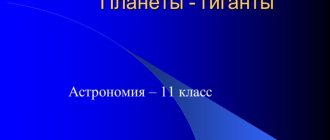LAWS OF MOTION OF THE PLANETS OF THE SOLAR SYSTEM Bushkov Pavel. - presentation
LAWS OF MOTION OF THE PLANETS OF THE SOLAR SYSTEM Bushkov Pavel
Many scientists until the beginning of the 17th century. believed that the movement of celestial bodies should be uniform and occur along the “most perfect” curve - a circle. Johannes Kepler Kepler managed to overcome this prejudice and establish the actual shape of planetary orbits, as well as the pattern of changes in the speed of planets as they revolve around the Sun. In his searches, Kepler proceeded from the conviction that “number rules the world,” expressed by Pythagoras. He looked for relationships between various quantities characterizing the movement of planets, the size of orbits, the period of revolution, and speed. Kepler acted virtually blindly, purely empirically.
Tycho Brahe When constructing the orbit of Mars, Kepler used his own observations of the planet, as well as many years of determinations of the coordinates and configurations of Mars carried out by his teacher Tycho Brahe. Johannes Kepler
Kepler considered the Earth's orbit (to a first approximation) to be a circle, which did not contradict observations. Construction of the orbit of Mars by Kepler Let us know the angular distance of Mars from the point of the vernal equinox during one of the oppositions of the planet (α 1), where T 1 and M 1 are the positions of the Earth and Mars in orbit. After 687 days (the sidereal period of Mars’ orbit), the planet will arrive at the same point in its orbit. The Earth at this moment is at point T 2, and, therefore, angle α 2 is the right ascension of Mars. Having repeated similar operations for several other oppositions of Mars, Kepler obtained a whole series of points and, drawing a smooth curve along them, constructed the orbit of the planet.
Johannes Kepler Kepler considered the Earth's orbit (to a first approximation) to be a circle, which did not contradict observations. In constructing the orbit of the planet Mars, Kepler was faced with the need to choose one of two possible solutions: 1) assume that the orbit of Mars is a circle, and assume that in some parts of the orbit the calculated coordinates of the planet diverge from observations (due to observation errors ) by 8′; 2) assume that observations do not contain such errors, and the orbit is not a circle. Confident in the accuracy of Tycho Brahe's observations, Kepler chose the second solution.
Kepler discovered that the orbit of Mars is not a circle, but a curve called an ellipse, and the Sun is not located at the center of the ellipse. An ellipse is a curve in which the sum of the distances from any point to its foci is a constant value. Johannes Kepler
Illustration of Kepler's first law using the example of the movement of the Earth's satellites. Each planet revolves around the Sun in an ellipse, at one of the foci of which the Sun is located. Kepler's first law The semimajor axis characterizes the size of the planet's orbit. Perihelion is the point of the orbit closest to the Sun. Aphelion is the point of the orbit farthest from the Sun.
Kepler's second law The radius vector of a planet describes equal areas in equal periods of time. Illustration of Kepler's second law using the example of the movement of the Earth's satellites As a planet approaches the Sun, its speed increases - kinetic energy increases, but due to a decrease in the distance to the Sun, potential energy decreases. According to the law of conservation of energy, the total mechanical energy of a closed system of bodies between which gravitational forces act remains unchanged during any movements of the bodies of this system. Therefore, the sum of the kinetic and potential energies of the planet, which moves around the Sun, is constant at all points of the orbit and is equal to the total energy.
Illustration of Kepler's third law using the example of the movement of the Earth's satellites. The squares of the sidereal periods of revolution of the planets are related to each other as the cubes of the semi-major axes of their orbits. Kepler's third law
Johannes Kepler “What I decided to look for 16 years ago has finally been found, and this discovery has exceeded all my wildest expectations...” Johannes Kepler The third law allows us to calculate the relative distances of the planets from the Sun, using the already known periods of their revolution around the Sun . There is no need to determine the distance from the Sun for each of them; it is enough to measure the distance from the Sun of at least one planet. The magnitude of the semimajor axis of the earth's orbit - the astronomical unit (AU) - became the basis for calculating all other distances in the solar system.
Task. Oppositions of a certain planet are repeated every two years. What is the semimajor axis of its orbit? What planetary configuration is appropriate for the problem?
Questions (p. 62) 1. Formulate Kepler's laws. 2. How does the speed of the planet change as it moves from aphelion to perihelion? 3. At what point in the orbit does the planet have maximum kinetic energy; maximum potential energy?
Homework 1)§ 12. 2) Exercise Mars is 1.5 times farther from the Sun than the Earth. How long is a year on Mars? The orbits of the planets are considered circular. 2. The synodic period of a small planet is 500 days. Determine the semimajor axis of its orbit and the stellar period of revolution.
Vorontsov-Velyaminov B.A. Astronomy. A basic level of. 11th grade : textbook/ B.A. Vorontsov-Velyaminov, E.K.Strout. - M.: Bustard, - 238 with CD-ROM “Library of electronic visual aids “Astronomy, grades 9-10”. Physicon LLC gif jpg png jpg jpg gif gif
Laws of planetary motion
Lesson topic:
Laws of planetary motion.
Lesson objectives:
- Educational
: introduce the formulations and limits of applicability of the three laws of planetary motion (Kepler’s laws).
- Developmental
: develop logical thinking, correct speech, use appropriate terminology.
- Educational
: achieve high class activity, attention, and concentration of students in the lesson.
Equipment:
disk "Open Physics",
presentation on the topic “Laws of planetary motion”
2 pins, thread, pencil.
Experiment:
drawing of an ellipse, virtual experiment “Kepler’s Laws”.
DURING THE CLASSES
I. Updating knowledge
- Hello guys! Sit down! Today we will continue to study the knowledge of the sky and in the lesson we will get acquainted with the three laws of motion of planets and artificial bodies of the Solar System. Now let’s check how you have mastered the material from previous classes.
II. Checking homework
(Each student is given task cards)
Indicate the contribution of each scientist to the study of the solar system:
1. Nicolaus Copernicus 1. In 150 AD. in the book "Almagest" described
- Galileo Galilei's geocentric system of the world.
- Johannes Kepler 2. Based on observed data, he derived three laws
- Claudius Ptolemy of the movements of the planets.
- Isaac Newton 3. The first to use a telescope for astronomical
research and discovered the phases of Venus.
4.Wrote a book in which he outlined the heliocentric
theory of planetary motions. It was published
in the year of his death (1543).
5.Formulated the law of universal gravitation.
III. Explanation of new theoretical material
Since ancient times, it was believed that celestial bodies move along “ideal curves” - circles. In Copernicus' theory, circular motion was also not questioned. However, in the 17th century it became clear that in fact the orbits of celestial bodies differ from circles. This important discovery belongs to Johannes Kepler.
Kepler did not doubt the correctness of the basic principles of Copernicus's teaching, but he knew that there were discrepancies between the calculated and observed positions of the planets. To eliminate this discrepancy, Kepler had to abandon the circular and uniform motion of the planets. To determine the heliocentric orbits of the planets, he used the observations of the Danish astronomer Tycho Brahe.
Kepler studied the movement of Mars especially carefully. The result of his many years of work is the discovery of three basic laws of planetary motion. These laws are named after Kepler.
Kepler's first law
The orbit of each planet is an ellipse, at one of the foci ( F 1 ) of which the Sun is located
. or
Under the influence of gravity, one celestial body can move in relation to another in a circle, ellipse, parabola or hyperbola.
Ellipse
(Figure 2) is a flat closed curve that has the property that the sum of the distances of each point from two points, called
foci,
remains constant.
This sum of distances is equal to the length of the major axis of the ellipse. Point O is the center of the ellipse, F1 and F2 are the foci. The Sun is in this case at focus F1. The point of the orbit closest to the Sun is called perihelion,
the farthest point is called
aphelion.
The line connecting any point of the ellipse with the focus is called
the radius vector.
The ratio of the distance between the foci to the major axis (to the largest diameter) is called
eccentricity e
.
The ellipse is more elongated, the greater its eccentricity. The semimajor axis of the ellipse a
is the average distance of the planet from the Sun.
Comets and asteroids also move in elliptical orbits. A circle has e = 0,
an ellipse
has 0
, a parabola
has e = 1,
and a hyperbola
has e 1.
Figure 1. The orbits of planets are ellipses, differ little from circles;
their eccentricities are small. For example, the eccentricity of the Earth's orbit is e = 0.017.
Working with the “Open Physics” disk (virtual experiment)
1.Identification of the quantities on which the shape of the ellipse depends, the degree of its difference from the circle.
2.Identification of quantities on which the shape of the orbit of celestial bodies depends.
Kepler's second law
The radius vector of the planet describes equal areas in equal time intervals
(determines the speed of the planet’s orbit).
The closer a planet is to the Sun, the faster it is. [1] Figure 3. The planet travels from point A to A1 and from B to B1 (Figure 3) in the same time. In other words, the planet moves fastest at perihelion, and slowest when it is at its greatest distance (at aphelion). Thus, the speed of Comet Halley at perihelion is 55 km/s, and at aphelion 0.9 km/s. Mercury, which is closest to the Sun, orbits the Sun in 88 days. Venus moves behind it, and a year on it lasts 225 Earth days. The Earth revolves around the Sun in 365 days, that is, exactly one year. The Martian year is almost twice as long as the Earth's. A Jupiter year is equal to almost 12 Earth years, and distant Saturn circles its orbit in 29.5 years! In short, the farther the planet is from the Sun, the longer the year on the planet.
And Kepler tried to find a relationship between the sizes of the orbits of various planets and the time of their revolution around the Sun. On May 15, 1618, after many unsuccessful attempts, Kepler finally established a very important relation known as
Kepler's third law
The squares of the sidereal periods of revolution of two planets are related as the cubes of the semimajor axes of their orbits.
If the orbital periods of any two planets, for example Earth and Mars, are denoted by Tz and Tm, and their average distances from the Sun are az and am, then Kepler’s third law can be written as an equality:
T2m / T2z = a3m / a3z.
But the period of revolution of the Earth around the Sun is equal to one year (Тз = 1), and the average distance between the Earth and the Sun is taken as one astronomical unit (az = 1 AU). Then this equality will take a simpler form:
T2m = a3m
The orbital period of a planet (in our example, Mars) can be determined from observations. It is 687 Earth days, or 1.881 years. Knowing this, it is not difficult to calculate the average distance of the planet from the Sun in astronomical units:
Those. Mars is on average 1,524 times farther from the Sun than our Earth. Consequently, if the orbital time of a planet is known, then its average distance from the Sun can be found from it. In this way, Kepler was able to determine the distances of all the planets known at that time:
Mercury – 0.39, Venus – 0.72, Earth – 1.00, Mars – 1.52, Jupiter – 5.20, Saturn – 9.54.
Only these were relative distances - numbers showing how many times a particular planet is further from the Sun or closer to the Sun than the Earth. The true values of these distances, expressed in earthly measures (in km), remained unknown, because the length of the astronomical unit - the average distance of the Earth from the Sun - was not yet known. Kepler's third law connected the entire solar family into a single harmonious system. The search took nine difficult years. The scientist’s perseverance won!
Conclusion:
Kepler's laws theoretically developed the heliocentric doctrine and thereby strengthened the position of new astronomy. Copernican astronomy is the wisest of all works of the human mind. [1]
Subsequent observations showed that Kepler's laws apply not only to the planets of the Solar System and their satellites, but also to stars physically connected to each other and revolving around a common center of mass. They formed the basis of practical astronautics, since all artificial celestial bodies move according to Kepler’s laws, starting with the first Soviet satellite and ending with modern spacecraft. It is no coincidence that in the history of astronomy Johannes Kepler is called the “legislator of the sky.”
IV. Experiment
Take a sheet of thick white paper and stick two pins into it. Now between the pins you need to use a pencil to stretch a thread with tied ends and move the pencil along the paper - it will draw an ellipse. Figure 4. Inside the ellipse there are two points (holes pierced by pins) that have a remarkable property: the sum of the two lines connecting these points to any point of the ellipse is always the same and equal to the length of the major axis (i.e., the largest diameter) of the ellipse. These two points are called the focuses of the ellipse, and every straight line connecting the focus to any point of the ellipse is a radius vector. If we divide the distance between the foci by the length of the major axis, we get a ratio called eccentricity
of this ellipse. Eccentricity characterizes the elongation of the ellipse. The greater the eccentricity of the ellipse, i.e. the greater the distance between the foci with the same length of the major axis, the more elongated it is. With an eccentricity equal to unity, i.e. in absolute value equal to the length of the major axis of the ellipse, the latter turns into an open curve - a parabola. As the eccentricity decreases, the elongation of the ellipse, on the contrary, decreases, and when the eccentricity becomes zero, the ellipse turns into a circle.
V. Lesson summary
What distance is called an astronomical unit?
— Average distance of the Earth from the Sun.
What is an astronomical unit?
?
1 a.u. = 149,600,000 km.
Formulate Kepler's 1st law.(2, 3)
Task.
It has been noticed that oppositions of a certain planet are repeated after 2 years.
What is the semimajor axis of its orbit?
VI. Homework
§9, question 2, p.42.
Bibliography:
- Korotzev O.N.
Astronomy: Popular Encyclopedia. – St. Petersburg: ABC-classics, 2003.
- E.P. Levitan Astronomy 11. Moscow “Enlightenment” 2007.
Lesson plan:
1) Ellipse;
2) Kepler's first law; 3) Kepler's II law; 4) Kepler's III law
Ellipse.
Ellipse formula.
Fig.2 The most important lines and points of the ellipse.
Sections: OV, OV′
– semi-minor axis;
OA, OA′
– semimajor axis.
Points: A′
- aphelion, the farthest point of the planet’s orbit from the Sun;
A
– perihelion, the point of planet F’s orbit closest to the Sun
, F′
– foci.
e = ОF/OA – eccentricity.
1 a. e.=149,600,000 km.
Kepler's laws.
1
. The orbit of each planet is an ellipse, with the Sun at one of the focuses. 2. Radius - the vector of the planet describes equal areas in equal periods of time. 3. The squares of the sidereal periods of revolution of two planets are related as the cubes of the semimajor axes of their orbits
.
Homework: §9, question 2, p.42
Fig.1 .
Dependence of the shape of the orbit of an artificial celestial body on the initial speed v 0. Orbits at different initial velocities (velocity vectors in all cases are directed horizontally, i.e. perpendicular to the radius of the Earth):
1 – circular (v0=7.9 km/s);
2.3 - elliptical (with v0 respectively equal to 10 km/s; 10.8 km/s);
4 – parabolic (v0 ≈ 11.2 km/s);
5 – hyperbolic (v0 ≈12.0 km/s).
Rice. 3
Rice. 4
Kepler's first law
This is an elliptical law. In our system, the planets rotate in an ellipse. In addition, the Sun is at one of the foci of this curve. The shape of the ellipse and its similarity to a circle are determined by eccentricity. This is an expression of the cross section of a cone in numerical measure. Moreover, it is he who indicates the degree of deviation from the circle. It is calculated by dividing the distance from the center to the focus of the ellipse by the semimajor axis. If the distance is zero, then the ellipse will be a circle.
Kepler's first law
The discovery and use of the law of universal gravitation in astronomy is proof of Kepler's first law. The law of universal gravitation established that every object in the Universe attracts another object along a certain line. Which, among other things, connects their centers of mass. But at the same time, it is proportional to the mass of each object, and inversely proportional to the square of the distance between these objects. Newton developed the law of universal gravitation.
Kepler's first law is interconnected with Newton's laws. In his second law, Newton argued and proved that the acceleration of an object is proportional to the resultant of all forces. Which are attached to the object. In addition, acceleration is also inversely proportional to the mass of the object.
Application of Kepler's laws
The laws of planetary motion in astronomy follow Kepler's laws. In them, the scientist gives an explanation and definition of the inhomogeneous movement of cosmic bodies. In addition, thanks to these laws, it became possible to establish the position of objects. Moreover, with their help you can calculate the mass of bodies. It is interesting that the majority of planets in the solar system have orbits close to a circle. Although a special bulge is characteristic of Mars and Pluto.
Orbits of the planets of the solar system
It is obvious that the laws of planetary motion are equivalent to the rules of satellite motion. By the way, even artificial ones. That is, what we launch into space moves according to these same principles. We can conclude that thanks to knowledge of the laws of motion, the launch of space rockets became possible. This means a huge step has been taken in the direction of studying the Universe.
Of course, Kepler made enormous contributions to astronomy. He can be called an amazing person in every sense. At the time he lived, no one imagined the Universe the way he did. Moreover, he himself wrote about himself: This person was destined to spend time solving difficult problems that frighten others. And indeed, thanks to his work, planetary astronomy was formed. You could say that a window to the Universe has opened. Where, what we see, we can measure. However, initially only two laws were published. Later, ten years later, Kepler's third law became available to the public.
Astronomy
Of course, not all guesses of scientific minds are correct. But they definitely made their contribution. We have already said that throughout the study of astronomy, many important discoveries have been made. Today, I think, we have once again examined and confirmed this.
Kepler's third law
Its name is often called the harmonious law. It implies that the period of rotation of a planet squared around the Sun is related to the cube of the semimajor axis of the planet's orbit. According to the rules of gravity, Kepler's law is not entirely accurate. Among other things, it must take into account the mass of the planet. The harmonic law, taking into account the law of gravity, is relevant to use to measure the mass of a space object. But only if their orbits are established.
Kepler's third law
Kepler's third law shows the relationship between the distance from a planet to a star and the orbital period. Simply put, the closer a planet is to the Sun, the faster it spins.




